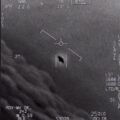UK astronomers studying the clouds of Venus have detected what they describe as a robust phosphine signal in their latest set of observations, adding to the case for alien life.
A variant of phosphorus, phosphine in these concentrations, is a strong biosignature, meaning that if found on Earth, the best explanation would be it is being made from biological life.
With further analysis to be done, the confirmation that there is (or isn’t) life in the clouds of Venus is unlikely to come before the 2030s.
Controversial Detection of Phosphine in 2020 Has Now Been Verified Multiple Times
Back in September 2020, researchers announced the first detection of phosphine gas in the clouds of Venus. The story grabbed national headlines due to the fact that the specific altitude the gas was detected was a location scientists had previously theorized had the right temperature and pressure to support certain forms of low-oxygen environment microbial life found here on Earth.
Specifically, the types of Earthling microbial life that could both produce phosphine and thrive in the environment of the Venusian clouds are part of a class of hardy organisms referred to as extremophiles for their ability to survive and even thrive in extreme environments.
Almost immediately, that detection was followed up by a failed detection, putting the original results and the hopes of finding alien life in jeopardy.
“Instead of phosphine in the clouds of Venus, the data are consistent with an alternative hypothesis: They were detecting sulfur dioxide,” said co-author Victoria Meadows, a UW professor of astronomy at the time. “Sulfur dioxide is the third-most-common chemical compound in Venus’ atmosphere, and it is not considered a sign of life.”
Undaunted, the original team reconfirmed their results with all new observations in 2022, once again hinting that the best explanation for the concentrations and altitudes of the detected phosphine was extremophiles.
“A reanalysis of the legacy data collected by the NASA Pioneer Venus Neutral Gas Mass Spectrometer (LNMS) (13) at the altitude of 51.3 km shows evidence of PH3 in the clouds of Venus,” the researchers explained. “(Furthermore) PH3 (phosphine) is the only P-containing molecule that fits the data and is in gas form at Venus’ 51.3 km altitude.”
Now, a new team of researchers says they have not only reevaluated the data that challenged the original finding, but they have also detected phosphine in a whole new set of readings, once again fostering hopes for finding the first signs of life outside of Earth.
Five Separate Readings Confirm Phosphine in Clouds of Venus
“We now have five detections over the last few years, from three different sets of instruments and from many methods of processing the data,” said Professor Jane Greaves, an astrobiologist at the School of Physics and Astronomy at Cardiff University and a member of the team who made the recent discovery. “We’re getting a clue here that there is some steady source (of phosphine), which is the point of legacy surveys—to show whether that’s true or not.”
These latest readings were the result of 50 hours of observations by the James Clark Maxwell Telescope (JCMT) in Hawaii, which took place from Feb 2022 to May 2023. Notably, the original 2020 detection consisted of eight hours of observations, making this latest detection the most robust yet.
Greaves and her team also took a fresh look at the data gathered by NASA’s Stratospheric Observatory for Infrared Astronomy (SOFIA) airplane that failed to replicate the 2020 findings. But instead of failure, she says tweaking the way the data from that analysis was processed revealed that they likely detected phosphine after all.
“I did one tiny tweak to the way they looked at the data, and you can certainly get something out,” said Greaves. “I didn’t do anything elaborate—just standard techniques.”
After these latest detections and confirmations, Greaves presented the team’s findings at the National Astronomy Meeting 2023 at Cardiff University in Wales, UK.
More Observation and Future Missions Hope To Settle Extraterrestrial Life Debate
While the latest findings certainly don’t confirm the presence of life, the team says another 150 hours of observations using the JCMT are scheduled to make the detection of phosphine iron clad. Of course, the researchers concede that any irrefutable confirmation of life (or some other natural process) as the source of the phosphine is likely not to be made until missions to the planet’s atmosphere occur sometime in the 2030s.
The best bet from the upcoming missions is NASA’s DAVINCI+ (Deep Atmosphere Venus Investigation of Noble gases, Chemistry, and Imaging Plus) probe which is currently scheduled to plunge through the clouds of Venus sometime in 2031. Unfortunately, the researchers say there is a chance that DAVINCI+ won’t even allocate one of its detection tools to look for the source of the phosphine since the mission has been planned since well before the 2020 detection.
“They have four of these laser wavelengths to allocate, and only three are decided,” explained Greaves. “We made our case for phosphine, and we’re just waiting to hear back (from mission planners).”
Ultimately, the argument is likely to go until at least 2031, but until then, these latest findings are another sign that there may indeed be life in the clouds of Venus.
Christopher Plain is a Science Fiction and Fantasy novelist and Head Science Writer at The Debrief. Follow and connect with him on X, learn about his books at plainfiction.com, or email him directly at christopher@thedebrief.org.

